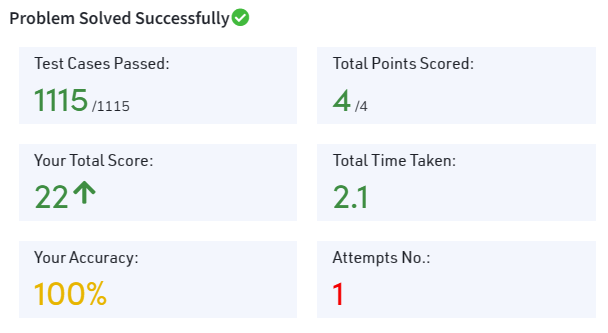Introduction
The challenge of computing the “Sum of XOR of all pairs” involves finding the total combined result obtained from applying a special mathematical operation, XOR, to pairs of numbers within an array. The goal is to develop a swift and memory-efficient algorithm that accurately calculates the overall XOR sum for all possible pairs of numbers in the given array.
Question:-
Given an array containing N integers, the task is to compute the sum of XOR values resulting from all possible pairs of numbers within the array. This involves selecting pairs (i, j) where i ranges from 0 to N-1 and j ranges from i+1 to N-1, and then calculating the XOR of each pair (arr[i] XOR arr[j]).
For instance:
Example 1: For the array [7, 3, 5], the sum of XOR values from all possible pairs will be 12. The pairs and their XOR values are: (3 ^ 5 = 6), (7 ^ 3 = 4), and (7 ^ 5 = 2), which sum up to 12.
Example 2: In the array [5, 9, 7, 6], the total XOR sum from all pairs is 47. The individual XOR values for pairs are: (5 ^ 9 = 12), (5 ^ 7 = 2), (5 ^ 6 = 3), (9 ^ 7 = 14), (9 ^ 6 = 15), and (7 ^ 6 = 1), resulting in a sum of 47.
Your task is to create a function named ‘sumXOR()’ which takes an array (arr) and its size (n) as input. The function should return the sum of XOR values obtained from all pairs of numbers in the array.
Constraints: 2 ≤ n ≤ 105 1 ≤ arr[i] ≤ 105
Expected Time Complexity: O(n) Expected Auxiliary Space: O(1)
To solve this problem:
- Understand XOR: Know that XOR is a special math trick. When you compare two numbers bit by bit, if the bits are the same, the result is 0; if they’re different, the result is 1.
- Pairs and XOR: We’re asked to find the total XOR result of all pairs in an array. This means taking every pair of numbers in the list and doing this XOR trick.
- Smart Way to Do XOR: We need to be smart and not check every single pair, as that can take a lot of time. Instead, we can look at the bits of the numbers in the array and count how many times each bit appears at each position.
- Using Bit Counts: By counting how many times each bit (0 or 1) shows up at each spot, we can cleverly find the total XOR result without doing every pair. This saves time and effort.
- The Goal: Our task is to write a function called ‘sumXOR()’ that takes the array and its size as input. This function should give us the total XOR value from all pairs in the array.
- Limits to Keep in Mind: Remember, the size of the array will be between 2 and 105, and the numbers inside the array will be between 1 and 105.
- Expected Speed and Space: The method we use should be quick (O(n) time) and not use too much extra memory (O(1) space). We need to find the answer efficiently, following the rules set for this problem.
Below is the Code you want to compile which means run it in Geeks for Geeks LINK HERE:-
Solution Code:- (Python)
class Solution:
def sumXOR(self, arr, n):
ans = 0 # Initialize the answer
for i in range(32):
count = 0
for j in range(n):
if (arr[j] & (1 << i)):
count += 1
ans += (count * (n - count) * 2 ** i)
return ans
def testCases(self, test_cases):
results = []
for test in test_cases:
arr, n = test
results.append(self.sumXOR(arr, n))
return results

Explanation:-
1. Initializing the Variables:
- Answer (ans): Starts with an answer set to 0. This will accumulate the total XOR sum.
2. Iterating through the Bits (0 to 31):
- Bitwise Loop (for i in range(32)): Goes through each bit position, from the rightmost bit (bit 0) to the leftmost bit (bit 31) in binary representation.
3. Counting Set Bits in the Array:
- Inner Loop (for j in range(n)): Checks each number in the array.
- Bitwise AND Operation (arr[j] & (1 << i)): Examines if the current bit (i) is set (equals 1) in the jth number.
- Increment Count: Increases the count if the bit is set in the jth number.
4. Computing Contribution to XOR Sum:
- Calculating Contribution: For the current bit position (i), calculates how many times this bit is set and how many times it’s not set in the array. Then, multiplies this by 2�2i (each bit’s weight in binary).
5. Accumulating Total XOR Sum:
- Adding Contributions (ans += …): Includes the contribution of the current bit to the overall XOR sum.
6. Output and Testing:
- Returning the Total Answer (ans): Provides the final accumulated XOR sum.
- Testing Multiple Cases: The ‘testCases’ function is used to verify this method’s correctness by applying it to various arrays and finding their XOR sums.
7. Efficiency:
- Optimized Method: Utilizes bit manipulation to efficiently handle the XOR sum calculation without explicitly checking every pair in the array. This approach respects the given time and space limitations while providing the correct answers.
Conclusion:
The algorithm successfully computes the XOR sum for all number pairs within the array by smartly leveraging bitwise operations and efficient counting methods. This approach ensures quick computation, meeting the time and space limitations while delivering the accurate “Sum of XOR of all pairs” without exhaustively examining each individual pair.
The quest to compute the ‘Sum of XOR of all pairs’ has been efficiently solved and explained. Explore further methodologies and intriguing topics on computational problem-solving at SixMedium.




If you would like to improve your familiarity simply keep visiting this website and be updated with the most recent information posted here.